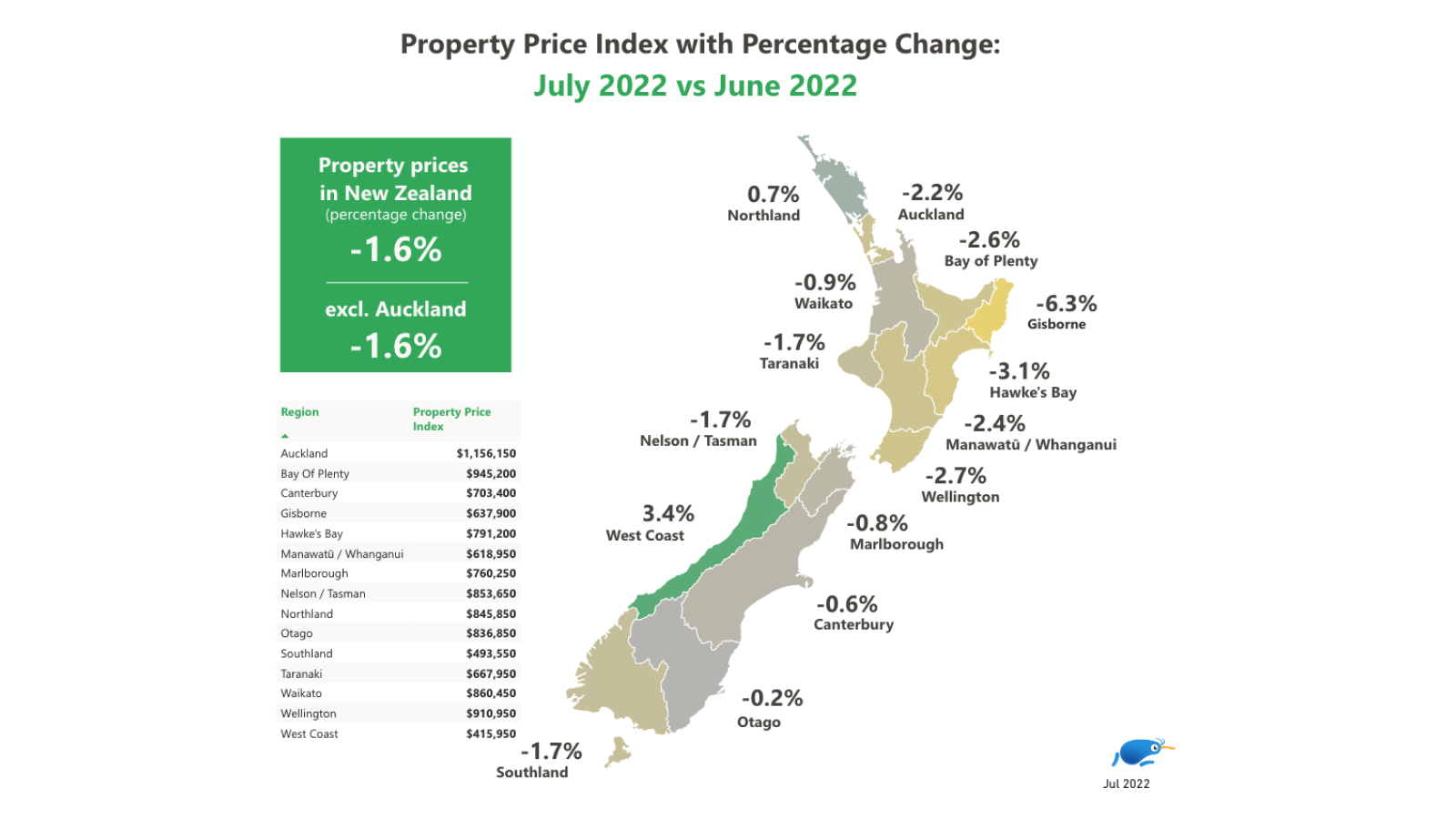The number of properties for sale across the country saw the biggest year-on-year jump ever in July, while prices continued to drop according to the latest Trade Me Property Price Index.
Trade Me Property Sales Director Gavin Lloyd said last month, nationwide supply spiked by 54 per cent when compared with July 2021. “The market has well and truly flipped and we’ve now seen property supply increase year-on-year for eight months straight.
“July marked the second month in a row where nationwide listing numbers jumped by more than 50 per cent year-on-year and every region saw an increase in the number of properties for sale when compared with the same month last year.”
| Region | Supply % change | Demand % change | |||
|---|---|---|---|---|---|
| Hawke's Bay | Hawke's Bay | +99% | +99% | +22% | +22% |
| Nelson/Tasman | Nelson/Tasman | +97% | +97% | +15% | +15% |
| Wellington | Wellington | +90% | +90% | +12% | +12% |
| Bay of Plenty | Bay of Plenty | +86% | +86% | +3% | +3% |
| Waikato | Waikato | +84% | +84% | -5% | -5% |
| Manawatū/Whanganui | Manawatū/Whanganui | +77% | +77% | +6% | +6% |
| Northland | Northland | +56% | +56% | +7% | +7% |
| Gisborne | Gisborne | +55% | +55% | +8% | +8% |
| Taranaki | Taranaki | +54% | +54% | -4% | -4% |
| Canterbury | Canterbury | +45% | +45% | -15% | -15% |
| Auckland | Auckland | +39% | +39% | -14% | -14% |
| Marlborough | Marlborough | +31% | +31% | -4% | -4% |
| Otago | Otago | +31% | +31% | +4% | +4% |
| Southland | Southland | +25% | +25% | -9% | -9% |
| West Coast | West Coast | +12% | +12% | -15% | -15% |
| Nationwide | Nationwide | +54% | +54% | -5% | -5% |
While supply increased across the board, Mr Lloyd said some spots were more impacted than others. “Hawke’s Bay and Nelson/Tasman were the standouts, with both regions seeing supply almost double in July when compared with the same month in 2021.
“The Wellington region was not far behind, seeing supply jump by 90 per cent in July when compared with 12 months ago.”
Mr Lloyd said on the other hand nationwide, demand fell by 5 per cent year-on-year last month. “The largest demand drops were seen in the Canterbury (-15%), West Coast (-15%) and Auckland (-14%) regions.”
Prices slump for three consecutive months
Mr Lloyd said the coupling of high supply with comparatively low demand has seen price growth slow down over the past few months. “The national average asking price was $910,450 in July, down 2 per cent when compared with June.
The largest month-on-month average asking price drops were seen in Gisborne (-6%), Hawke’s Bay (-3%), Wellington (-3%) and the Bay of Plenty (down 3%).
When compared with July 2021, the national average asking price climbed by 9 per cent last month. “While this is still tough for house hunters, it’s the smallest year-on-year percentage increase we have seen in 24 months.”
Looking ahead, Mr Lloyd said prices might fall even further. “We’re seeing a significantly higher number of properties for sale during what are typically quiet winter months than we have seen over the past couple of summers, when we would usually expect to see the market at its peak.
“It’s going to be very interesting to see what happens as the weather warms up. If supply increases even further while demand remains low, we may well see prices continue to cool off. This would make for a more approachable market, particularly for those looking to get a foot on the property ladder for the first time.”
Price growth slows in the Capital
The Wellington region saw an average asking price of $910,950 last month. “When compared with July 2021, this marks a 6 per cent increase, the smallest year-on-year jump on record for the region.”
Looking at Wellington City, Mr Lloyd said the district’s average asking price fell by 1 per cent month-on-month, to $1,041,300 in July. “Despite this, it was the most expensive district in the region, followed by Porirua ($956,300) and South Wairarapa ($879,450).”
The Capital’s most popular property in July was a four-bedroom, three-bathroom house on Tiber Street in Island Bay. “The house was watchlisted 546 times in its first seven days onsite.”
Auckland prices see smallest growth in two years
In the Auckland region, last month's average asking price jumped 5 per cent when compared with July 2021, to $1,156,150. "This is the region’s smallest year-on-year increase since April 2020."
The most expensive district in the Auckland region last month was Waiheke Island, sitting at $1,781,950. “The North Shore City district came in second, with an average asking price of $1,345,400, followed by Rodney ($1,294,850).
“Last month’s most popular property in the Auckland region was a four-bedroom, four-bathroom house on Tawa Road in Kumeu, Rodney. It was watchlisted 298 times in it's first seven days onsite.”

